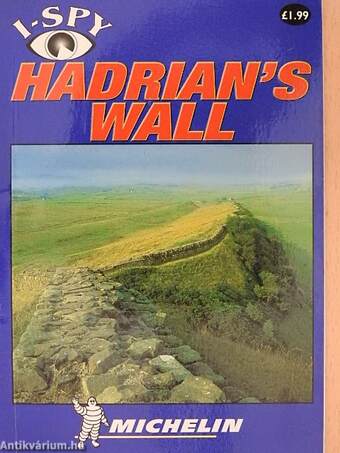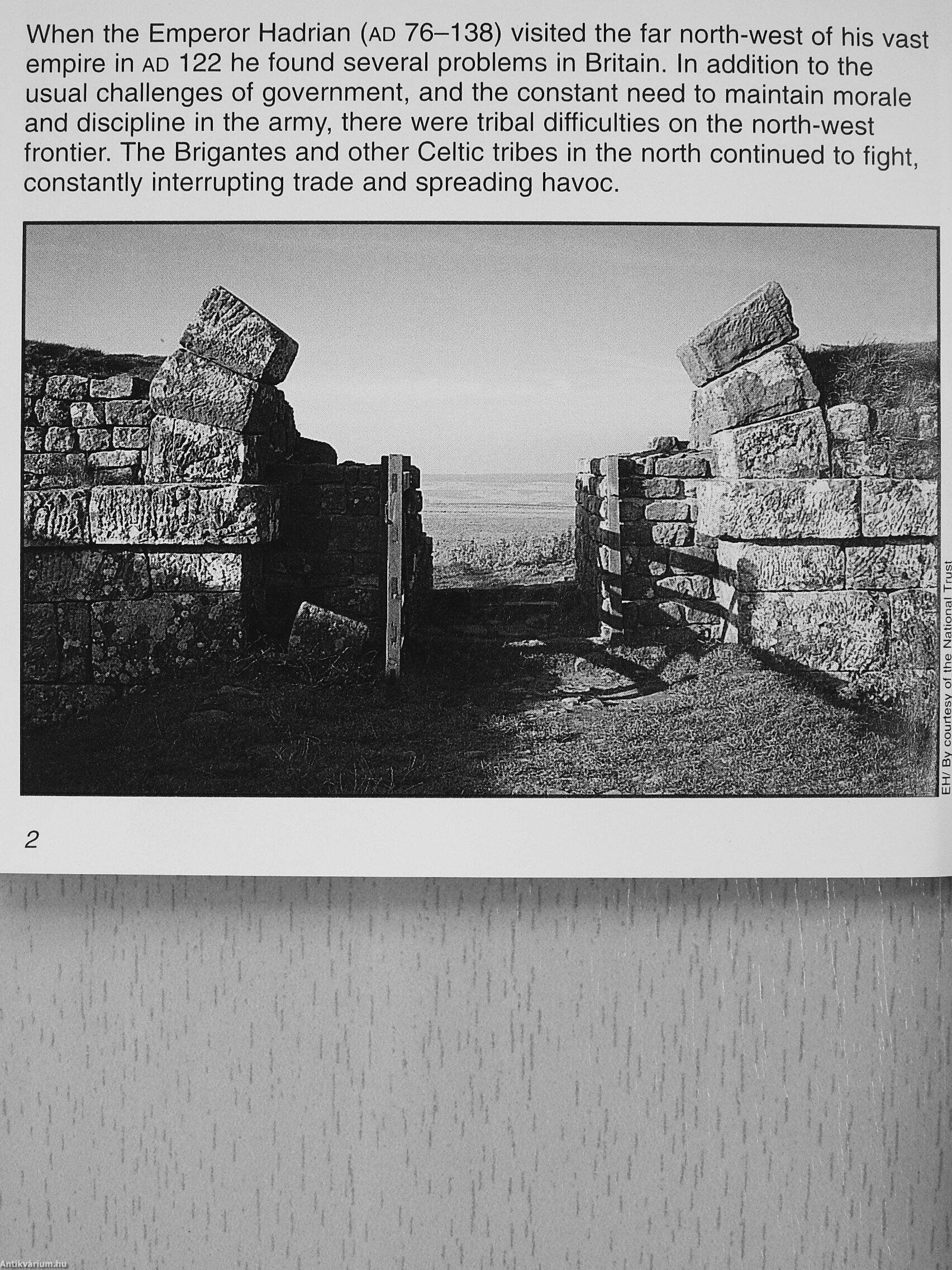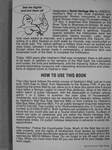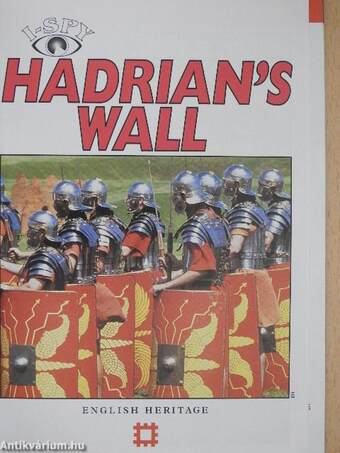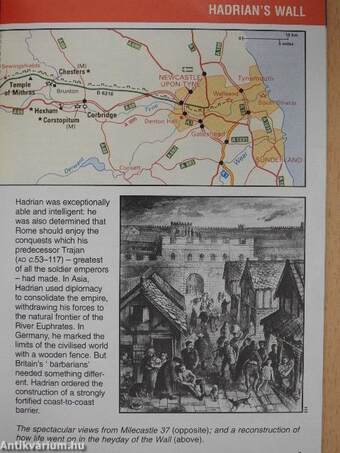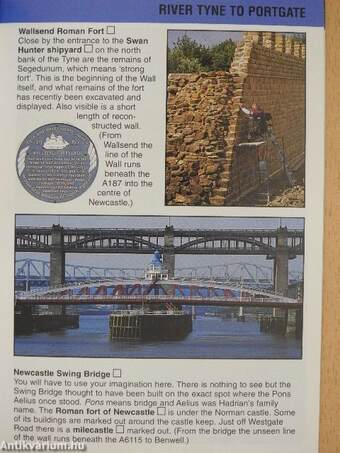1.066.452
kiadvánnyal nyújtjuk Magyarország legnagyobb antikvár könyv-kínálatát

VISSZA
A TETEJÉRE
JAVASLATOKÉszre-
vételek
Hadrian's Wall
| Kiadó: | Michelin Tyre Public Limited Company-I-Spy Limited |
|---|---|
| Kiadás helye: | Watford |
| Kiadás éve: | |
| Kötés típusa: | Varrott papírkötés |
| Oldalszám: | 48 oldal |
| Sorozatcím: | English Heritage |
| Kötetszám: | |
| Nyelv: | Angol |
| Méret: | 15 cm x 10 cm |
| ISBN: | 1-85671-212-5 |
| Megjegyzés: | Fekete-fehér és színes fotókkal, illusztrációkkal. |
naponta értesítjük a beérkező friss
kiadványokról
naponta értesítjük a beérkező friss
kiadványokról
Előszó
TovábbFülszöveg
Designated a World Heritage Site by UNESCO, Hadrian's Wall is the most important and spectacular Roman monument in Britain. Eighty Roman miles long (73 modern miles or 117 km), it stretched from Wallsend on the River Tyne to Bowness-on-Solway. At every Roman mile along its entire length a small fort (milecastle) guarded a gateway. Equally spaced between the milecastles were two observation towers (turrets). Later, larger forts were added at intervals, and a great earthwork (the Vallum), consisting of a ditch flanked on both sides by mounds, was constructed on the south side. The Vallum defined a military zone much as barbed wire does today; between it and the Wall a military road connected the forts. Except where the terrain made it unnecessary, a defensive ditch was excavated north of the Wall, to complete the fortification.
Today, 1800 years after Hadrian's Wall was completed, there is still plenty to be seen. In addition to the remains of the Wall itself, the milecastles and... Tovább
Fülszöveg
Designated a World Heritage Site by UNESCO, Hadrian's Wall is the most important and spectacular Roman monument in Britain. Eighty Roman miles long (73 modern miles or 117 km), it stretched from Wallsend on the River Tyne to Bowness-on-Solway. At every Roman mile along its entire length a small fort (milecastle) guarded a gateway. Equally spaced between the milecastles were two observation towers (turrets). Later, larger forts were added at intervals, and a great earthwork (the Vallum), consisting of a ditch flanked on both sides by mounds, was constructed on the south side. The Vallum defined a military zone much as barbed wire does today; between it and the Wall a military road connected the forts. Except where the terrain made it unnecessary, a defensive ditch was excavated north of the Wall, to complete the fortification.
Today, 1800 years after Hadrian's Wall was completed, there is still plenty to be seen. In addition to the remains of the Wall itself, the milecastles and turrets, the forts and settlements, and the imposing Vallum, there are several fascinating museums with interesting reconstructions and collections of objects found at Hadrian's Wall.
HOW TO USE THIS BOOK
This l-Spy book follows the entire course of Hadrian's Wall, just as it was built, from East to West: from Newcastle to the Solway Firth. If you are exploring the entire Wall by car, allow up to 4 days (the same time it would have taken a Roman Legion to march that distance). Most of the Wall is within reach of public transport, with the Newcastle to Carlisle railway within 1 or 2 miles. In summer, the main sites of Housesteads, Vindolanda, and Chesters can be reached from Hexham railway station by Hadrian's Wall Bus East (Service 890) or from Carlisle by Hadrian's Wall Bus West (Service 682). For all public transport enquiries telephone (01670) 533128. This number is for Northumberland only. In Cumbna, the number is (01228) 812812. Both numbers are available only during office hours but you could also ask at a Tourist Information Centre, fourteen of which are open at weekends and are within the World Heritage Site. Unless opening hours are given, the sites featured can be visited at all reasonable times. On public holidays telephone in advance to avoid disappointment.
Remember: Follow the Countryside Code. Much of the Wall lies on private property, and the rights of landowners must always be respected. Walkers and cyclists should take special care on the busy A69 and on the spectacular B6318 Military Road. Do not forget to tick off each site you l-Spy When you have more than 60 you can send off for your badge (see back page).
Back and front cover; English Heritage Vissza
Témakörök
- Idegennyelv > Idegennyelvű könyvek > Angol > Művészetek > Építészet
- Idegennyelv > Idegennyelvű könyvek > Angol > Művészetek > Művészettörténet, általános
- Idegennyelv > Idegennyelvű könyvek > Angol > Történelem > Európa története > Egyéb
- Művészetek > Művészettörténet általános > Idegen nyelv > Angol
- Művészetek > Művészettörténet általános > Korszakok, stílusok > Ókor > Római > Építészet
- Művészetek > Építészet > Korszakok, stílusok > Ókor > Római
- Művészetek > Építészet > Idegen nyelv > Angol
- Művészetek > Építészet > Műemlékek > Egyéb
- Történelem > Idegennyelvű > Angol
- Történelem > Ókor > Római Birodalom
- Történelem > Hadtörténet > Várak, erődítmények
Megvásárolható példányok
Nincs megvásárolható példány
A könyv összes megrendelhető példánya elfogyott. Ha kívánja, előjegyezheti a könyvet, és amint a könyv egy újabb példánya elérhető lesz, értesítjük.



